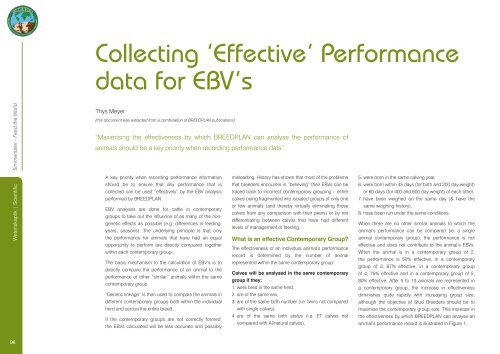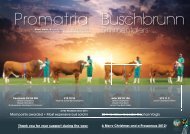Simmentaler Joernaal 2013.indb
Simmentaler Joernaal 2013.indb
Simmentaler Joernaal 2013.indb
Create successful ePaper yourself
Turn your PDF publications into a flip-book with our unique Google optimized e-Paper software.
<strong>Simmentaler</strong> - Feed the World<br />
Wetenskaplik | Scientific<br />
96<br />
Collecting ‘Effective’ Performance<br />
data for EBV’s<br />
Thys Meyer<br />
(this document was extracted from a combination of BREEDPLAN publications)<br />
“Maximising the effectiveness by which BREEDPLAN can analyse the performance of<br />
animals should be a key priority when recording performance data”.<br />
A key priority when recording performance information<br />
should be to ensure that any performance that is<br />
collected can be used “effectively” by the EBV analysis<br />
performed by BREEDPLAN.<br />
EBV analyses are done for cattle in contemporary<br />
groups to take out the influence of as many of the nongenetic<br />
effects as possible (e.g. differences in feeding,<br />
years, seasons). The underlying principle is that only<br />
the performance for animals that have had an equal<br />
opportunity to perform are directly compared together<br />
within each contemporary group.<br />
The basic mechanism to the calculation of EBV’s is to<br />
directly compare the performance of an animal to the<br />
performance of other “similar” animals within the same<br />
contemporary group.<br />
“Genetic linkage” is then used to compare the animals in<br />
different contemporary groups both within the individual<br />
herd and across the entire breed.<br />
If the contemporary groups are not correctly formed,<br />
the EBVs calculated will be less accurate and possibly<br />
misleading. History has shown that most of the problems<br />
that breeders encounter in “believing” their EBVs can be<br />
traced back to incorrect contemporary grouping – either<br />
calves being fragmented into isolated groups of only one<br />
or few animals (and thereby virtually eliminating those<br />
calves from any comparison with their peers) or by not<br />
differentiating between calves that have had different<br />
levels of management or feeding.<br />
What is an effective Contemporary Group?<br />
The effectiveness of an individual animal’s performance<br />
record is determined by the number of animal<br />
represented within the same contemporary group.<br />
Calves will be analysed in the same contemporary<br />
group if they:<br />
1. were bred in the same herd,<br />
2. are of the same sex,<br />
3. are of the same birth number (i.e. twins not compared<br />
with single calves),<br />
4. are of the same birth status (i.e. ET calves not<br />
compared with AI/natural calves),<br />
5. were born in the same calving year,<br />
6. were born within 45 days (for birth and 200 day weight)<br />
or 60 days (for 400 and 600 day weight) of each other,<br />
7. have been weighed on the same day (& have the<br />
same weighing history),<br />
8. have been run under the same conditions.<br />
When there are no other similar animals to which the<br />
animal’s performance can be compared (ie. a single<br />
animal contemporary group), the performance is not<br />
effective and does not contribute to the animal’s EBVs.<br />
When the animal is in a contemporary group of 2,<br />
the performance is 50% effective, in a contemporary<br />
group of 3, 67% effective, in a contemporary group<br />
of 4, 75% effective and in a contemporary group of 5,<br />
80% effective. After 5 to 10 animals are represented in<br />
a contemporary group, the increase in effectiveness<br />
diminishes quite rapidly with increasing group size,<br />
although the objective of Stud Breeders should be to<br />
maximise the contemporary group size. This increase in<br />
the effectiveness by which BREEDPLAN can analyse an<br />
animal’s performance record is illustrated in Figure 1.



